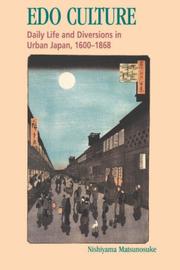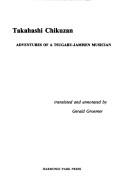| Listing 1 - 10 of 16 | << page >> |
Sort by
|
Book
ISBN: 0824877179 Year: 2018 Publisher: Honolulu : University of Hawaii Press,
Abstract | Keywords | Export | Availability | Bookmark
 Loading...
Loading...Choose an application
- Reference Manager
- EndNote
- RefWorks (Direct export to RefWorks)
Japanese zuihitsu (essays) offer a treasure trove of information and insights rarely found in any other genre of Japanese writing. Especially during their golden age, the Edo period (1600-1868), zuihitsu treated a great variety of subjects. In the pages of a typical zuihitsu the reader encountered facts and opinions on everything from martial arts to music, food to fashions, dragons to drama-much of it written casually and seemingly without concern for form or order. The seven zuihitsu translated and annotated in this volume date from the early seventeenth to the late nineteenth centuries. Some of the essays are famous while others are less well known, but none have been published in their entirety in any Western language. Following a substantial introduction outlining the development of the genre, "Tales That Come to Mind" is an early seventeenth-century account of Edo kabuki theater and the Yoshiwara "pleasure quarters" penned by a Buddhist monk. "A Record of Seven Offered Treasures," composed by a retired samurai-monk near the end of the seventeenth century, starts as a treatise on the proper education of youth but ends as a critique of the author's own life and moral failings. Perhaps the most famous piece in the volume, "Monologue," was drafted by the renowned Confucianist Dazai Shundai, a keen and insightful observer of life during the late seventeenth and early eighteenth centuries. Dazai treats, in turn, poetry, the tea ceremony, comic verse, music, theater, and fashion. "Nagasaki Prattle" is an entertaining record of a journey to Nagasaki by a group of Confucianists in the early eighteenth century. In "Kyoto Observed," a mid-eighteenth-century Edo resident compares the shogun's and the emperor's capital in a series of brief vignettes. An 1814 zuihitsu classic written by a physician, "A Dustheap of Discourses" presents another colorful mosaic of topics related to life in Edo. The book closes with "The Breezes of Osaka," a lively essay by a highly cultured Edo administrator contrasting the food, life, and culture of his hometown with that of Osaka, where he briefly served as mayor in the 1850s.
Book
ISBN: 9811373760 9811373752 Year: 2019 Publisher: Singapore : Springer Singapore : Imprint: Palgrave Macmillan,
Abstract | Keywords | Export | Availability | Bookmark
 Loading...
Loading...Choose an application
- Reference Manager
- EndNote
- RefWorks (Direct export to RefWorks)
This volume presents a series of five portraits of Edo, the central region of urban space today known as Tokyo, from the great fire of 1657 to the devastating earthquake of 1855. This book endeavors to allow Edo, or at least some of the voices that constituted Edo, to do most of the speaking. These voices become audible in the work of five Japanese eye-witness observers, who notated what they saw, heard, felt, tasted, experienced, and remembered. “An Eastern Stirrup,” presents a vivid portrait of the great conflagration of 1657 that nearly wiped out the city. “Tales of Long Long Ago,” details seventeenth-century warrior-class ways as depicted by a particularly conservative samurai. “The River of Time,” describes the city and its flourishing cultural and economic development during the late eighteenth and early nineteenth centuries. “The Spider’s Reel” looks back at both the attainments and calamities of Edo in the 1780s. Finally, “Disaster Days,” offers a meticulous account of Edo life among the ruins of the catastrophic 1855 tremor. Read in sequence, these five pieces offer a unique “insider’s perspective” on the city of Edo and early modern Japan. .
Japan-History. --- Oriental literature. --- Cities and towns-History. --- History of Japan. --- Asian Literature. --- Urban History. --- Asian literature --- Japan—History. --- Cities and towns—History.
Book
ISBN: 9781138924024 9781315684680 9781317409885 9781317409892 9781138477162 1138477168 Year: 2015 Publisher: Abingdon, Oxon ; New York, NY : Routledge,
Abstract | Keywords | Export | Availability | Bookmark
 Loading...
Loading...Choose an application
- Reference Manager
- EndNote
- RefWorks (Direct export to RefWorks)
Street theater --- Street entertainers --- History. --- Buskers --- Street people (Street entertainers) --- Street performers --- Entertainers --- Civilization --- J6843.30 --- J6800.60 --- Japan: Performing arts and entertainment -- variety entertainments -- circusses, performances of skill, and trained animal shows --- Japan: Performing and media arts -- history -- Kinsei, Edo, Tokugawa period, early modern (1600-1867)
Book
ISBN: 9780190259044 9780190259037 Year: 2016 Publisher: New York Oxford University Press
Abstract | Keywords | Export | Availability | Bookmark
 Loading...
Loading...Choose an application
- Reference Manager
- EndNote
- RefWorks (Direct export to RefWorks)
Book
ISBN: 0824894650 Year: 2022 Publisher: Honolulu : University of Hawaii Press,
Abstract | Keywords | Export | Availability | Bookmark
 Loading...
Loading...Choose an application
- Reference Manager
- EndNote
- RefWorks (Direct export to RefWorks)
Before the twentieth century, Japanese religious and cultural life was shaped by a variety of yearly ceremonies, festivals, and customs. These annual events (nenju gyoji) included Shinto festivals in which participants danced through the night to boisterous music and Buddhist temple practices that honored deities, great priests, or temple founders with solemn rituals and prayers—and sometimes, when the Buddha was invoked, raucous dancing. Temples also hosted popular fairs, where holy objects and artwork were displayed to the faithful and curious. Countless other celebrations were held annually at the residences of the nobility and military elite and at commoner domiciles. Kyoto, the imperial—and cultural—capital since the eighth century, was the center of many of these events. From Kyoto festivals, rituals, and celebrations diffused to other parts of the land, ultimately shaping religious, artistic, and everyday life as a whole. By the seventeenth century the Kyoto public wished to inform itself more accurately about nenju gyoji and their dates and meanings. As a result, a growing number of guidebooks and almanacs were written and published for the urban populace.This volume is the first to present translations of two such publications. Introductory chapters explain Japanese conceptions of time and space within which annual celebrations took place and outline how ceremonies and festivals in and about Kyoto were chronicled, described, and interpreted from the earliest times to the seventeenth century. The final two chapters offer annotated translations of writings from the seventeenth century that catalogue and describe the dates, sites, meanings, and histories of many Kyoto annual events. The two works, one largely historical, the other more ethnographic in nature, indicate not only when and where observances and commemorations took place, but also how their authors understood the significance of each. Both translations feature a large number of illustrations depicting events as they appeared in Kyoto at the time.
Festivals --- History --- Sakauchi, Naoyori, --- Namura, Jōhaku, --- Kyoto (Japan) --- Social life and customs --- Calendars.
Book
ISBN: 9780824877170 Year: 2018 Publisher: Honolulu
Abstract | Keywords | Export | Availability | Bookmark
 Loading...
Loading...Choose an application
- Reference Manager
- EndNote
- RefWorks (Direct export to RefWorks)
Book
ISBN: 9780824894658 Year: 2022 Publisher: Honolulu
Abstract | Keywords | Export | Availability | Bookmark
 Loading...
Loading...Choose an application
- Reference Manager
- EndNote
- RefWorks (Direct export to RefWorks)

ISBN: 0824817362 0824818504 9780824818500 9780824817367 Year: 1997 Publisher: Honolulu, HI : University of Hawaii Press,
Abstract | Keywords | Export | Availability | Bookmark
 Loading...
Loading...Choose an application
- Reference Manager
- EndNote
- RefWorks (Direct export to RefWorks)
Japan --- Civilization --- 1600-1868 --- J4140.60 --- J4000.60 --- J3360 --- J4190.12 --- J4192 --- Japan: Sociology and anthropology -- cultural history -- Kinsei, Edo, Tokugawa period, early modern (1600-1867) --- Japan: Social history, history of civilization -- Kinsei, Edo, Tokugawa period, early modern (1600-1867) --- Japan: History -- Kinsei, Edo, Tokugawa period, early modern (1600-1867) --- Japan: Sociology and anthropology -- local communities and culture -- Kantō -- Tōkyō 23 ward area (Edo) --- Japan: Sociology and anthropology -- communities -- urban groups, the city --- J4150.60 --- Japan - Civilization - 1600-1868
Book
ISBN: 0824862295 0585309523 Year: 1997 Publisher: Honolulu : University of Hawaii Press,
Abstract | Keywords | Export | Availability | Bookmark
 Loading...
Loading...Choose an application
- Reference Manager
- EndNote
- RefWorks (Direct export to RefWorks)
Nishiyama Matsunosuke is one of the most important historians of Tokugawa (Edo) popular culture, yet until now his work has never been translated into a Western language. Edo Culture presents a selection of Nishiyama's writings that serves not only to provide an excellent introduction to Tokugawa cultural history but also to fill many gaps in our knowledge of the daily life and diversions of the urban populace of the time. Many essays focus on the most important theme of Nishiyama's work: the seventeenth to nineteenth centuries as a time of appropriation and development of Japan's culture by its urban commoners. In the first of three main sections, Nishiyama outlines the history of Edo (Tokyo) during the city's formative years, showing how it was shaped by the constant interaction between its warrior and commoner classes. Next, he discusses the spirit and aesthetic of the Edo native and traces the woodblock prints known as ukiyo-e to the communal activities of the city's commoners. Section two focuses on the interaction of urban and rural culture during the nineteenth century and on the unprecedented cultural diffusion that occurred with the help of itinerant performers, pilgrims, and touring actors. Among the essays is a delightful and detailed discourse on Tokugawa cuisine. The third section is dedicated to music and theatre, beginning with a study of no, which was patronized mainly by the aristocracy but surprisingly by commoners as well. In separate chapters, Nishiyama analyzes the relation of social classes to musical genres and the aesthetics of kabuki. The final chapter focuses on vaudeville houses supported by the urban masses.
Japan --- Civilization

ISBN: 0899900526 Year: 1991 Publisher: Warren Harmonie Park Press
Abstract | Keywords | Export | Availability | Bookmark
 Loading...
Loading...Choose an application
- Reference Manager
- EndNote
- RefWorks (Direct export to RefWorks)
| Listing 1 - 10 of 16 | << page >> |
Sort by
|

 Search
Search Feedback
Feedback About
About Help
Help News
News